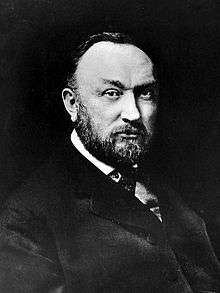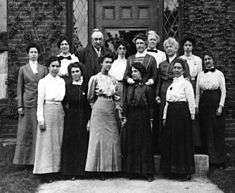Edward Charles Pickering
| Edward Charles Pickering | |
|---|---|
 | |
| Born |
July 19, 1846 Boston, Massachusetts |
| Died |
February 3, 1919 (aged 72) Cambridge, Massachusetts |
| Nationality | American |
| Alma mater | Harvard |
| Known for | spectroscopic binary stars |
| Awards |
Henry Draper Medal (1888) Valz Prize (1888) Bruce Medal (1908) Gold Medal of the Royal Astronomical Society (1886 and 1901) |
| Scientific career | |
| Fields | Astronomy |
Prof Edward Charles Pickering FRS(For) HFRSE (July 19, 1846 – February 3, 1919) was an American astronomer and physicist[1] and the older brother to William Henry Pickering.
Along with Carl Vogel, Pickering discovered the first spectroscopic binary stars. He wrote Elements of Physical Manipulations (2 vol., 1873–76).
Life
He was born in Boston on 19 July 1846 the son of Edward Pickering and his wife, Charlotte Hammond.[2]
Pickering was educated at Boston Latin School, and then studied Science at Harvard, where he received his BS degree in 1865. Soon after graduating from Harvard, Pickering taught physics at the Massachusetts Institute of Technology.[3] Later, he served as director of Harvard College Observatory from 1877 to his death in 1919, where he made great leaps forward in the gathering of stellar spectra through the use of photography.

At Harvard, he recruited over 80 women to work for him, including Annie Jump Cannon, Henrietta Swan Leavitt, and Antonia Maury. These women, the Harvard Computers (also described as "Pickering's Harem" by the scientific community at the time), made several important discoveries at HCO.[4] Leavitt's discovery of the period-luminosity relationship for Cepheids, published by Pickering,[5] would prove the foundation for the modern understanding of cosmological distances.
In 1864 he married Lizzie Wadsworth Sparks.[6]
In 1876 he co-founded the Appalachian Mountain Club.
Discoveries
In 1882, Pickering developed a method to photograph the spectra of multiple stars simultaneously by putting a large prism in front of the photographic plate.[7]
He also, along with Williamina Fleming and Annie Jump Cannon[8] designed a stellar classification system based on an alphabetic system for spectral classes that was first known as the Harvard Stellar Classification and became the basis for the Henry Draper Catalog.
In 1896, Pickering published observations of previously unknown lines in the spectra of the star ζ-Puppis.[9] These lines became known as the Pickering series[10] (or the Pickering–Fowler series[11]) and Pickering attributed them to hydrogen in 1897.[12][13] Alfred Fowler gave the same attribution to similar lines that he observed in a hydrogen-helium mixture in 1912.[14] Analysis by Niels Bohr included in his 'trilogy'[15][16] on atomic structure[17] argued that the spectral lines arose from ionised helium, He+, and not from hydrogen.[18] Fowler was initially-skeptical[19] but was ultimately convinced[20] that Bohr was correct,[15] and by 1915 "spectroscopists had transferred [the Pickering series] definitively [from hydrogen] to helium."[10][21] Bohr's theoretical work on the Pickering series had demonstrated the need for "a re-examination of problems that seemed already to have been solved within classical theories" and provided important confirmation for his atomic theory.[10]
Pickering is credited for making the Harvard College Observatory known and respected around the world, and it continues today to be a well-respected observatory and program.[22]
Honors
Awards and honors
- Fellow of the American Academy of Arts and Sciences (1867)[23]
- Gold Medal of the Royal Astronomical Society (1886 and 1901)
- Valz Prize of the French Academy of Sciences (1888)[24]
- Henry Draper Medal from the National Academy of Sciences (1888)[25]
- Bruce Medal (1908)
- Prix Jules Janssen, the highest award of the Société astronomique de France, the French astronomical society (1908)
Named after him
- The crater Pickering on the Moon
- The crater Pickering Mars.
- Asteroid 784 Pickeringia
(all jointly named after him and his brother William Henry Pickering)
Publications
- (1873–76) Elements of physical manipulation New York: Hurd & Houghton OCLC 16078533
- (1882) A plan for securing observations of the variable stars Cambridge: J. Wilson and Son OCLC 260332440
- (1886) An investigation in stellar photography Cambridge: J. Wilson and Son OCLC 15790725
- (1891) Preparation and discussion of the Draper catalogue Cambridge: J. Wilson and Son OCLC 3492105
- (1903) Plan for the endowment of astronomical research Cambridge: Astronomical observatory of Harvard College OCLC 30005226
- Pickering, EC (1912). "The Allegheny Observatory In Its Relation To Astronomy". Science. 36 (927) (published Oct 4, 1912). pp. 417–421. Bibcode:1912Sci....36..417P. doi:10.1126/science.36.927.417. PMID 17788756.
References
- ↑ "PICKERING, Edward Charles". The International Who's Who in the World. 1912. p. 856.
- ↑ Biographical Index of Former Fellows of the Royal Society of Edinburgh 1783–2002 (PDF). The Royal Society of Edinburgh. July 2006. ISBN 0 902 198 84 X.
- ↑ Daintith, John. (1999) A Dictionary of Scientists. Oxford: Oxford University Press.
- ↑ The 19th century women who catalogued the cosmos, Michelle Starr, Cnet News, March 7, 2016
- ↑ Miss Leavitt in Pickering, Edward C. "Periods of 25 Variable Stars in the Small Magellanic Cloud" Harvard College Observatory Circular 173 (1912) 1–3.
- ↑ Biographical Index of Former Fellows of the Royal Society of Edinburgh 1783–2002 (PDF). The Royal Society of Edinburgh. July 2006. ISBN 0 902 198 84 X.
- ↑ Bunch, Bryan H. and Hellemans, Alexander (2004) The History of Science and Technology: A Browser's Guide to the Great Discoveries, Inventions, and the People Who Made Them, from the Dawn of Time to Today. Boston: Houghton Mifflin.
- ↑ "Annie Jump Cannon -". www.projectcontinua.org. Retrieved 2016-03-31.
- ↑ Pickering, E. C. (1896). "Stars having peculiar spectra. New variable stars in Crux and Cygnus" (PDF). Harvard College Observatory. 12: 1–2. Also published as: Pickering, E. C.; Fleming, W. P. (1896). "Stars having peculiar spectra. New variable stars in Crux and Cygnus". Astrophysical Journal. 4: 369–370. Bibcode:1896ApJ.....4..369P. doi:10.1086/140291.
- 1 2 3 Robotti, Nadia (1983). "The Spectrum of ζ Puppis and the Historical Evolution of Empirical Data". Historical Studies in the Physical Sciences. 14 (1): 123–145. doi:10.2307/27757527.
- ↑ Lakatos, Imre (1980). "Bohr: A Research Programme Progressing on Inconsistent Foundations". In Worrall, John; Currie, Gregory. The Methodology of Scientific Research Programmes. Cambridge University Press. pp. 55–68. ISBN 9780521280310.
- ↑ Pickering, E. C. (1897). "Stars having peculiar spectra. New variable Stars in Crux and Cygnus". Astronomische Nachrichten. 142 (6): 87–90. Bibcode:1896AN....142...87P. doi:10.1002/asna.18971420605.
- ↑ Pickering, E. C. (1897). "The spectrum of zeta Puppis" (PDF). Astrophysical Journal. 5: 92–94. Bibcode:1897ApJ.....5...92P. doi:10.1086/140312.
- ↑ Fowler, A. (1912). "Observations of the Principal and other Series of Lines in the Spectrum of Hydrogen". Monthly Notices of the Royal Astronomical Society. 73 (2): 62–63. Bibcode:1912MNRAS..73...62F. doi:10.1093/mnras/73.2.62.
- 1 2 Hoyer, Ulrich (1981). "Constitution of Atoms and Molecules". In Hoyer, Ulrich. Niels Bohr – Collected Works: Volume 2 – Work on Atomic Physics (1912–1917). Amsterdam: North Holland Publishing Company. pp. 103-316 (esp. pp. 116-122). ISBN 0720418003.
- ↑ Kennedy, P. J. (1985). "A Short Biography". In French, A. P.; Kennedy, P. J. Niels Bohr: A Centenary Volume. Harvard University Press. pp. 3–15. ISBN 978-0-674-62415-3.
- ↑ Bohr, N. (1913). "On the constitution of atoms and molecules, part I" (PDF). Philosophical Magazine. 26 (151): 1–25. doi:10.1080/14786441308634955.
Bohr, N. (1913). "On the constitution of atoms and molecules, part II: Systems Containing Only a Single Nucleus" (PDF). Philosophical Magazine. 26 (153): 476–502. doi:10.1080/14786441308634993.
Bohr, N. (1913). "On the constitution of atoms and molecules, part III: Systems containing several nuclei". Philosophical Magazine. 26 (155): 857–875. doi:10.1080/14786441308635031. - ↑ Bohr, N. (1913). "The Spectra of Helium and Hydrogen". Nature. 92: 231–232. Bibcode:1913Natur..92..231B. doi:10.1038/092231d0.
- ↑ Fowler, A. (1913). "The Spectra of Helium and Hydrogen". Nature. 92: 95–96. Bibcode:1913Natur..92...95F. doi:10.1038/092095b0.
- ↑ Fowler, A. (1913). "Reply to: The Spectra of Helium and Hydrogen". Nature. 92: 232–232. Bibcode:1913Natur..92..232F. doi:10.1038/092232a0.
- ↑ Bohr, N. (1915). "The Spectra of Hydrogen and Helium". Nature. 95 (6–7). Bibcode:1915Natur..95....6B. doi:10.1038/095006a0.
- ↑ Clark, David H. and Clark, Matthew D. H. (2004). Measuring the Cosmos: How Scientists Discovered the Dimensions of the Universe. New Brunswick, N.J: Rutgers University Press.
- ↑ "Book of Members, 1780–2010: Chapter P" (PDF). American Academy of Arts and Sciences. Retrieved 7 April 2011.
- ↑ "Miscellaneous". Annual Report of the Board of Regents of the Smithsonian Institution, Part 1. Smithsonian Institution, Board of Regents. 1890. p. 192.
- ↑ "Henry Draper Medal". National Academy of Sciences. Archived from the original on 26 January 2013. Retrieved 19 February 2011.
External links
| Wikimedia Commons has media related to Edward Charles Pickering. |
| Wikisource has the text of the 1911 Encyclopædia Britannica article Pickering, Edward Charles. |
- Works by Edward Charles Pickering at Project Gutenberg
- Works by or about Edward Charles Pickering at Internet Archive
- Works by Edward Charles Pickering at LibriVox (public domain audiobooks)

- Edward Charles Pickering — Biographical Memoirs of the National Academy of Sciences
- Women Astronomers at Harvard at the Turn of the Century
- Obituaries